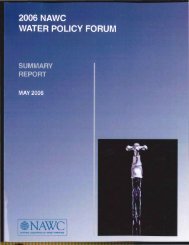BEECHER - NAWC
BEECHER - NAWC
BEECHER - NAWC
Create successful ePaper yourself
Turn your PDF publications into a flip-book with our unique Google optimized e-Paper software.
Water ComparedStructural Change3. Structural Change in the Utility SectorsStructural change, or restructuring, is affecting all of the utility industries. To one degree oranother, all are becoming more competitive and (hopefully) more efficient and effective inserving customers. But while the underlying paradigms of restructuring are common to all ofthe industries, change is being manifested in very different ways. Each industry must followits own course to the future.Restructuring in the energy and telecommunications sectors largely has meant a process ofbreaking up vertically integrated monopolies (although the recent trend of mergers provides anotable counterpoint), and opening access to transmission facilities. Restructuring in thewater industry, by contrast, involves consolidation and regionalization. As already noted,long-distance transmission of water resources is constrained for economic, environmental,and health reasons. Thus, restructuring will not take the form of creating a national watermarket. Nonetheless, competition is making its way into the water industry in other forms.The forces behind restructuring can be organized into the trilogy of concepts already used:technical, economic, and institutional. Together, these forces are transforming public utilities.Restructuring in thetelecommunications, electricity,and natural gas industries ...Restructuring in the waterindustry ...Technical FactorsFrom a technological standpoint, restructuring is the functional transformation of thetraditional, vertically integrated utility monopoly. The integrated monopoly provided all ofthe basic utility functions-generation (production), transmission (including storage asappropriate), and distribution. Under restructuring, different providers provide differentfunctions on an unbundled basis. In the telecommunications field, many new market entrantsreflect new services and technologies. In the energy sector, brokers and "aggregators" havebeen interjected between producers and customers. Under restructuring, utilities are"networked" competitors and customers have choices.<strong>NAWC</strong> 53 September 1998
















